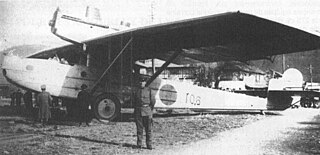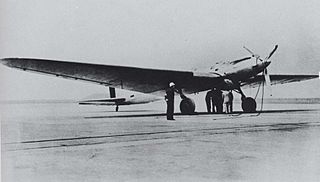Related Research Articles

The Nakajima E4N was a Japanese shipboard reconnaissance aircraft of the 1930s. It was a two-seat, single-engine, equal-span biplane seaplane used primarily by the Imperial Japanese Navy.

The Dornier N was a bomber aircraft designed in Germany in the 1920s for production in Japan. Production of 28 aircraft started in Japan in 1927, as the Kawasaki Ka 87. Designed and built as a landplane, its layout was strongly reminiscent of the Dornier flying boats of the same period; a parasol-wing, strut-braced monoplane with two engines, mounted in a push-pull nacelle above the wing. Some of the 28 examples built saw action in Manchuria in 1931.

The Manshū MT-1 Hayabusa was an airliner produced by the Japanese Manchuria Airplane Manufacturing Company in Manchukuo in the late 1930s. It was a conventional, low-wing cantilever monoplane with fixed tailwheel undercarriage. The flight deck was fully enclosed and separate from the passenger cabin, which could seat six people. The type equipped Manchukuo National Airways.
The Nakajima LB-2 was a long-range, land-based bomber developed in Japan for use by the Imperial Japanese Navy. When rejected for military service, the sole prototype was converted into an airliner and, known as the Akatsuki-go, was operated by Manchukuo National Airways.
The Nakajima C3N-1 was a prototype Japanese carrier-based reconnaissance aircraft of the 1930s. A single-engine monoplane with a fixed undercarriage, although only two examples were built, they were both used operationally, carrying out land-based reconnaissance missions during the Second Sino-Japanese War.

The Aichi E10A was a Japanese night reconnaissance flying boat of the 1930s. A single-engined biplane, 15 were built for the Imperial Japanese Navy as the Type 96 Night Reconnaissance Seaplane, serving from 1936 but were retired in 1941 before the Attack on Pearl Harbor.

The Hiro H2H, or "Navy Type 89 Flying boat", was a Japanese patrol flying boat of the 1930s. Designed and built by the Hiro Naval Arsenal, it was a twin-engined biplane that was operated by the Imperial Japanese Navy.

The Gasuden Koken was a Japanese long-range research aircraft of the 1930s. It was built by the Tokyo Gas and Electric Industry, to break the world record for longest flight, setting a closed circuit world record of 11,651.011 km (7,240 mi) in March 1938.
The Nakajima B3N was a prototype Japanese carrier-based torpedo-bomber aircraft of the 1930s. A single-engined biplane with a crew of three, it was unsuccessful, only two being built.

The Yokosuka K1Y, also known as the Navy Type 13 Trainer, was a Japanese single-engined biplane trainer of the 1920s. Designed by the Japanese Navy Arsenal at Yokosuka, over 100 were built by several manufacturers, the type being used by the Imperial Japanese Navy well into the 1930s.
The Aichi F1A was a prototype Japanese floatplane of the 1930s. A single-engined biplane, the F1A was intended as a short-range observation aircraft suitable for operation off the Imperial Japanese navy's warships, but only two were built, the Mitsubishi F1M being selected instead.
The Aichi AB-2 was a prototype Japanese reconnaissance floatplane of the 1930s. It was a single-engined biplane, of which two examples were built, but no production followed.

The Kawanishi K-8 Transport Seaplane was a Japanese single-engined floatplane of the 1920s. Seven were built in 1926 and 1927, and were used to operate airmail services.
The Nakajima D3N was a Japanese carrier-based dive bomber of the 1930s. Three prototypes were built for the Imperial Japanese Navy, but no production followed, with the Aichi D3A being selected instead.
The Tachikawa R-38 was a Japanese training aircraft of the late 1930s. It was a single-engined parasol monoplane that was intended for use by civil training schools. Two examples were built, with the Japanese Military's control of resources preventing any further production.
The Kawanishi K8K was a Japanese floatplane trainer designed and built by the Kawanishi Aircraft Company for the Imperial Japanese Navy. It was selected for production, but only a small number were built before a change in the Japanese Navy's training needs led to production being stopped.
The Nihon L7P was a Japanese military seaplane built in World War II in the early 1940s.
The Kawanishi E13K, company designation AM-19, was a Japanese 1930s three-seat reconnaissance floatplane.
The Watanabe K8W was a Japanese floatplane trainer designed and built by Watanabe for the Imperial Japanese Navy.

The Mitsubishi Ka-12 or B4M was a Japanese carrier-based torpedo bomber of 1934. Two prototypes were built by Mitsubishi for the Imperial Japanese Navy. A development of the company's 3MT10 of 1932, the design differed primarily in the use of a radial engine and metal wing, which made the whole aircraft significantly lighter and faster. However, the design could not realise its potential as the wing was inefficiently stiff and the B4M was not selected for production. The competing Yokosuka B4Y was chosen to serve on the Navy's aircraft carriers instead.
References
- ↑ Mikesh & Abe 1990, p. 92
- Mikesh, Robert C.; Abe, Shorzoe (1990). Japanese Aircraft 1910–1941. London: Putnam. ISBN 0-85177-840-2.
- The Illustrated Encyclopedia of Aircraft. London: Aerospace Publishing. p. 2174.
- Taylor, Michael J. H. (1989). Jane's Encyclopedia of Aviation. London: Studio Editions. p. 511.